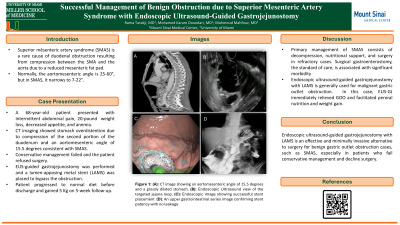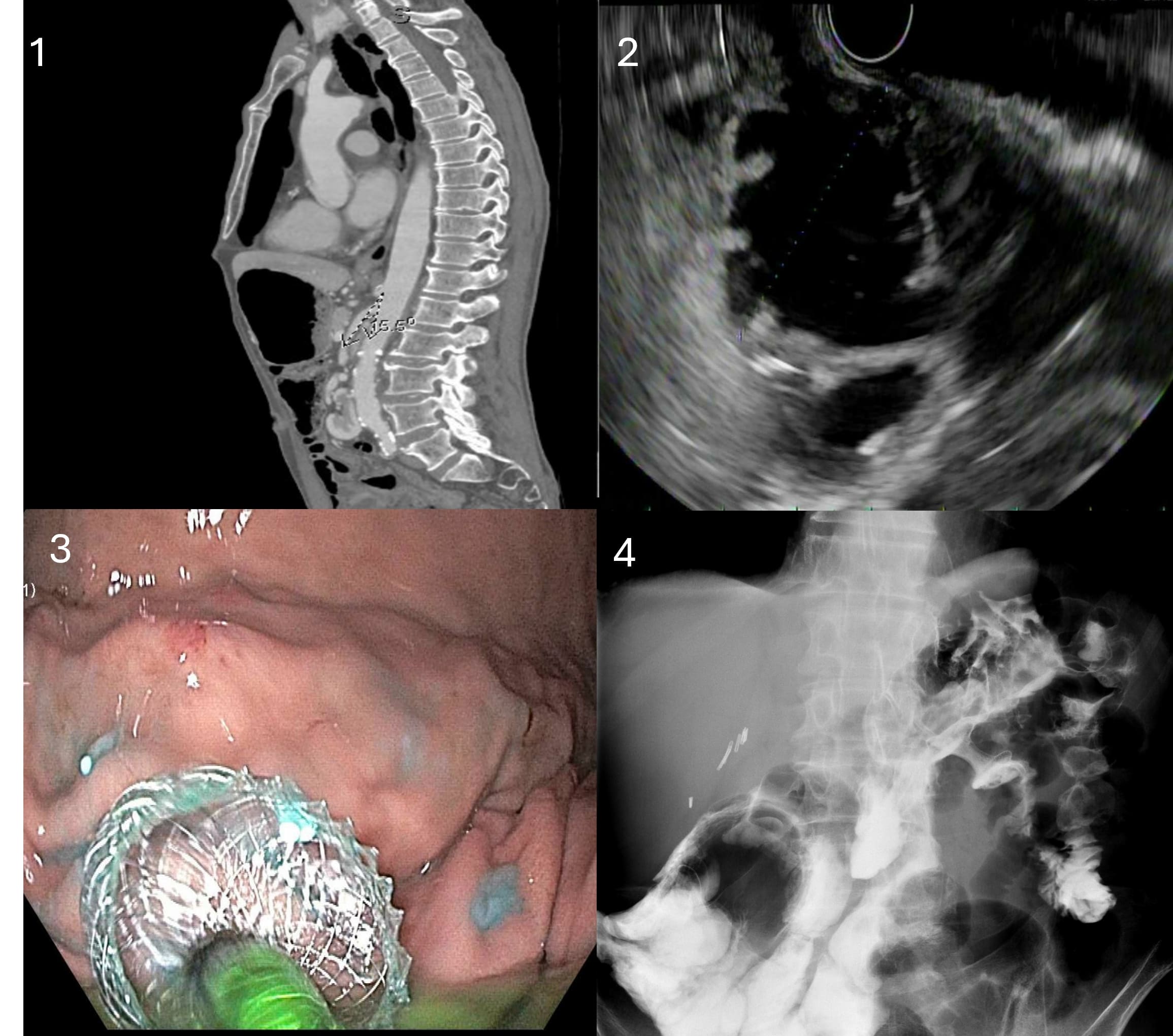Tuesday Poster Session
Category: Interventional Endoscopy
P4517 - Successful Management of Benign Obstruction Due to Superior Mesenteric Artery Syndrome With Endoscopic Ultrasound-Guided Gastrojejunostomy
Tuesday, October 29, 2024
10:30 AM - 4:00 PM ET
Location: Exhibit Hall E

Has Audio

Rama Tarakji, MD
Mount Sinai Medical Center
Miami Beach, FL
Presenting Author(s)
Rama Tarakji, MD1, Mohamed Karam Douedari, MD1, Mahmoud Mahfouz, MD2
1Mount Sinai Medical Center, Miami Beach, FL; 2University of Miami Miller School of Medicine, Miami, FL
Introduction: Superior mesenteric artery syndrome (SMAS) is a rare condition where the duodenum is obstructed by compression between the SMA and the aorta, due to a reduced mesenteric fat pad. Normally, the aortomesenteric angle is 25-60 degrees, but in SMAS, it decreases to 7-22 degrees. We present a case of a man with SMAS who failed conservative management and refused surgery. He was successfully treated with endoscopic ultrasound-guided gastrojejunostomy (EUS-GJ) by placing lumen-apposing metal stents (LAMS).
Case Description/Methods: A 68-year-old male with coronary artery disease, hypertension, depression, and kidney disease presented with intermittent abdominal pain, 20-pound weight loss, and decreased appetite over the past few months. He was anemic with hemoglobin at 9.6 g/dL. CT imaging ruled out neoplasia and revealed stomach overdistention due to compression of the second portion of the duodenum, with an aortomesenteric angle of 15.5 degrees (Figure 1), consistent with SMAS. Conservative management failed, and the patient refused surgery. An upper endoscopic exam showed sharp angulation and stenosis just before the second part of the duodenum. Endoscopic ultrasound-guided gastrojejunostomy (EUS-GJ) was performed with the placement of a 15 x 10 mm LAMS (Figure 2,3). An upper gastrointestinal series confirmed stent patency with no leakage (Figure 4). The patient progressed to a normal diet before discharge. On follow-up after five weeks, he gained 5 kg and was tolerating a regular diet.
Discussion: The primary management of SMAS involves decompression with fluid and electrolyte repletion, followed by nutritional support to promote weight gain. Refractory cases may require surgery. Surgical gastroenterostomy, the standard of care, is associated with significant morbidity. Endoscopic therapy, such as a gastrojejunal feeding tube, is used for patients unfit for surgery. EUS-GJ is an effective and less invasive alternative to surgery for gastric outlet obstruction (GOO). This procedure is generally used for malignant GOO. In this case, EUS-GJ provided immediate relief of (GOO) and facilitated peroral nutrition and weight gain, supporting its use as an effective and safe alternative to surgical intervention for benign GOO cases.

Disclosures:
Rama Tarakji, MD1, Mohamed Karam Douedari, MD1, Mahmoud Mahfouz, MD2. P4517 - Successful Management of Benign Obstruction Due to Superior Mesenteric Artery Syndrome With Endoscopic Ultrasound-Guided Gastrojejunostomy, ACG 2024 Annual Scientific Meeting Abstracts. Philadelphia, PA: American College of Gastroenterology.
1Mount Sinai Medical Center, Miami Beach, FL; 2University of Miami Miller School of Medicine, Miami, FL
Introduction: Superior mesenteric artery syndrome (SMAS) is a rare condition where the duodenum is obstructed by compression between the SMA and the aorta, due to a reduced mesenteric fat pad. Normally, the aortomesenteric angle is 25-60 degrees, but in SMAS, it decreases to 7-22 degrees. We present a case of a man with SMAS who failed conservative management and refused surgery. He was successfully treated with endoscopic ultrasound-guided gastrojejunostomy (EUS-GJ) by placing lumen-apposing metal stents (LAMS).
Case Description/Methods: A 68-year-old male with coronary artery disease, hypertension, depression, and kidney disease presented with intermittent abdominal pain, 20-pound weight loss, and decreased appetite over the past few months. He was anemic with hemoglobin at 9.6 g/dL. CT imaging ruled out neoplasia and revealed stomach overdistention due to compression of the second portion of the duodenum, with an aortomesenteric angle of 15.5 degrees (Figure 1), consistent with SMAS. Conservative management failed, and the patient refused surgery. An upper endoscopic exam showed sharp angulation and stenosis just before the second part of the duodenum. Endoscopic ultrasound-guided gastrojejunostomy (EUS-GJ) was performed with the placement of a 15 x 10 mm LAMS (Figure 2,3). An upper gastrointestinal series confirmed stent patency with no leakage (Figure 4). The patient progressed to a normal diet before discharge. On follow-up after five weeks, he gained 5 kg and was tolerating a regular diet.
Discussion: The primary management of SMAS involves decompression with fluid and electrolyte repletion, followed by nutritional support to promote weight gain. Refractory cases may require surgery. Surgical gastroenterostomy, the standard of care, is associated with significant morbidity. Endoscopic therapy, such as a gastrojejunal feeding tube, is used for patients unfit for surgery. EUS-GJ is an effective and less invasive alternative to surgery for gastric outlet obstruction (GOO). This procedure is generally used for malignant GOO. In this case, EUS-GJ provided immediate relief of (GOO) and facilitated peroral nutrition and weight gain, supporting its use as an effective and safe alternative to surgical intervention for benign GOO cases.

Figure: Figure 1. Computed Tomography (CT) image showing an aortomesenteric angle of 15.5 degrees and a grossly dilated stomach
Figure 2. Endoscopic Ultrasound view of the targeted jejunal loop
Figure 3. Endoscopic image showing successful stent placement
Figure 4. An upper gatrointestinal series image confirming stent patency with no leakage
Figure 2. Endoscopic Ultrasound view of the targeted jejunal loop
Figure 3. Endoscopic image showing successful stent placement
Figure 4. An upper gatrointestinal series image confirming stent patency with no leakage
Disclosures:
Rama Tarakji indicated no relevant financial relationships.
Mohamed Karam Douedari indicated no relevant financial relationships.
Mahmoud Mahfouz indicated no relevant financial relationships.
Rama Tarakji, MD1, Mohamed Karam Douedari, MD1, Mahmoud Mahfouz, MD2. P4517 - Successful Management of Benign Obstruction Due to Superior Mesenteric Artery Syndrome With Endoscopic Ultrasound-Guided Gastrojejunostomy, ACG 2024 Annual Scientific Meeting Abstracts. Philadelphia, PA: American College of Gastroenterology.

